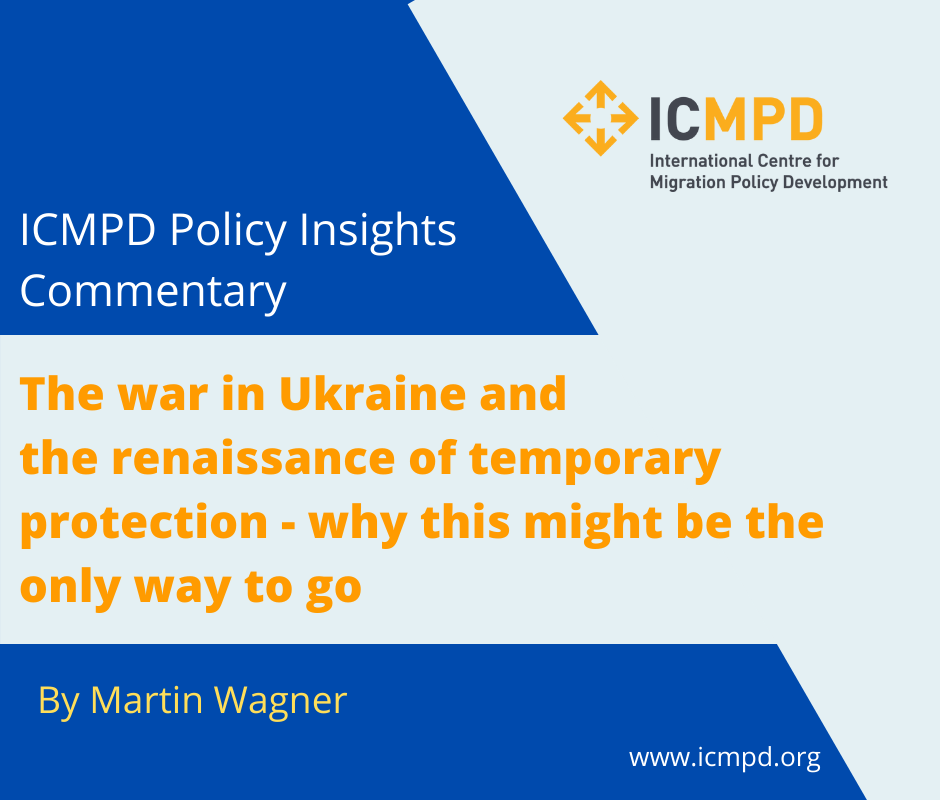On Thursday, 3 March 2022, an Extraordinary Justice and Home Affairs (JHA) Council meeting voted on a proposal by the European Commission to activate the EU’s Temporary Protection Directive for the first time for people fleeing the war in Ukraine.
In the new ICMPD Policy Insights Commentary published on 2 March 2022, Martin Wagner, a senior policy adviser at ICMPD, analyzed the Temporary Protection Directive and what it means for people. The Commentary is also available in Russian and Ukrainian languages.
With the war in Ukraine ongoing at a larger scale than anyone expected, many Ukrainians are forced to seek protection in neighbouring countries. The severity with which the Russian military is hitting all parts of Ukraine raises concerns of forced displacement on a scale unprecedented in Europe’s recent history. In less than a week, 874,000 people have already left Ukraine (as of 2 March) The neighbouring EU countries, Poland, Slovakia, Hungary, and Romania, have already shown a remarkably quick and unbureaucratic response, opening their borders and allowing people to enter. While immediate protection from physical harm is undoubtedly the most important aim, the decision on people’s legal status within the EU is and will be important, as it also determines their rights.
What protection is available?
The EU has been building its Common European Asylum System (CEAS) since 1999 to harmonise and standardise it across all 27 EU Member States. Essentially, these standards determine who shall receive protection and what rights come with this protection. The CEAS has three different statuses available for people in need of protection, which vary in their suitability for receiving refugees from Ukraine:
- Refugee protection
- Subsidiary protection
- Temporary protection
Both refugee and subsidiary protection are established by EU Member States in tedious and often long-lasting, individualised procedures to assess whether or not a person fulfils the criteria. The procedure would last even longer if high numbers of applicants enter the system within a short time. When the war in former Yugoslavia in the 1990s forced thousands of Bosnians to flee, countries like Austria or Germany soon saw their asylum systems collapsing. Lacking any appropriate instrument that could provide ad hoc protection to so many people, countries like Austria granted “temporary stay” to Bosnians, which ultimately served as a blueprint for the first EU asylum directive, the Temporary Protection Directive, in 2001.
Temporary protection – the EU instrument for a “mass influx”
While EU Member States have granted refugee or subsidiary protection status to thousands of people in need over the last two decades, no one was ever granted temporary protection according to the Temporary Protection Directive. This is because this instrument has never been triggered. For the Directive to be triggered, the Council must agree on a proposal by the Commission with a majority vote (at least 15 Member States that represent at least 65% of the EU population). There were some attempts in the past to draw on this instrument – in 2011, when many people crossed the Mediterranean from North African countries in the wake of the Arab Spring, and more prominently in the context of high numbers of refugee and migrant arrivals in 2015-2016 and the recent flight of Afghans following the Taliban takeover in August 2021. Still, the calls did not find enough support to trigger the instrument, and the Directive has been broadly labelled dead law. Now, with hundreds of thousands of Ukrainians arriving in eastern EU countries, this instrument may experience an unexpected renaissance.
The Temporary Protection Directive, above all, avoids lengthy procedures for determining whether someone is individually persecuted or faces indiscriminate violence. All those who arrive in large numbers (a “mass influx”) from a specific country or geographic region described by the Commission and adopted by the Council immediately enjoy temporary protection for at least one year. Temporary protection allows for access to employment and self-employment activities, education, housing, health care, and family unity. It basically contains most of the rights that come with refugee or subsidiary protection status – without the bureaucratic headache.
What next?
What is currently most important is to swiftly grant access to health care, housing, and other basic needs for a large number of people, who right now are largely women, children, and elderly men. This is what temporary protection can offer better than the conventional statuses. And in fact countries like Hungary, Slovakia, and Poland have already adopted or plan to adopt national emergency regulations that in essence provide temporary protection. But national approaches could lead to unwanted differences in protection across the EU.
Temporary protection, which has already been declared dead many times, could therefore see a historic revival as soon as tomorrow – probably not because it is the best instrument, but because it is the only one available right now. Still, it could become a key symbol of the much-needed unbureaucratic and unified EU response for Ukrainians suffering the darkest hour in our recent history.
Read the whole article on the ICMPD website.

